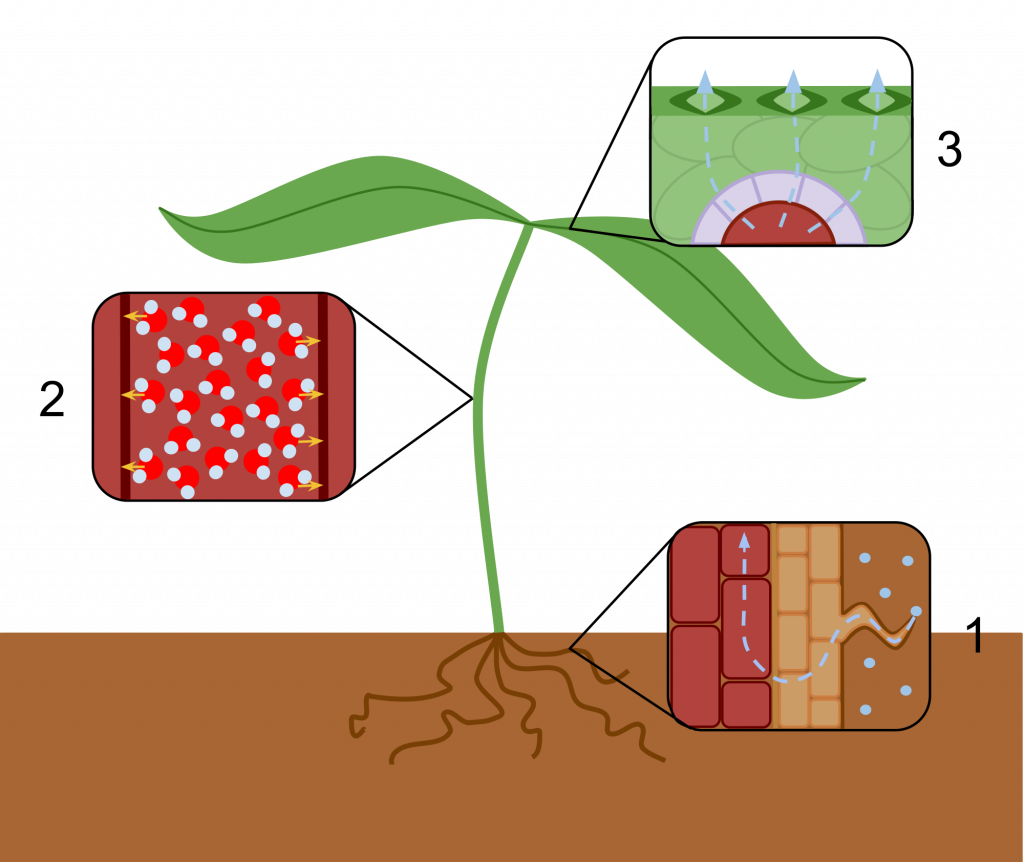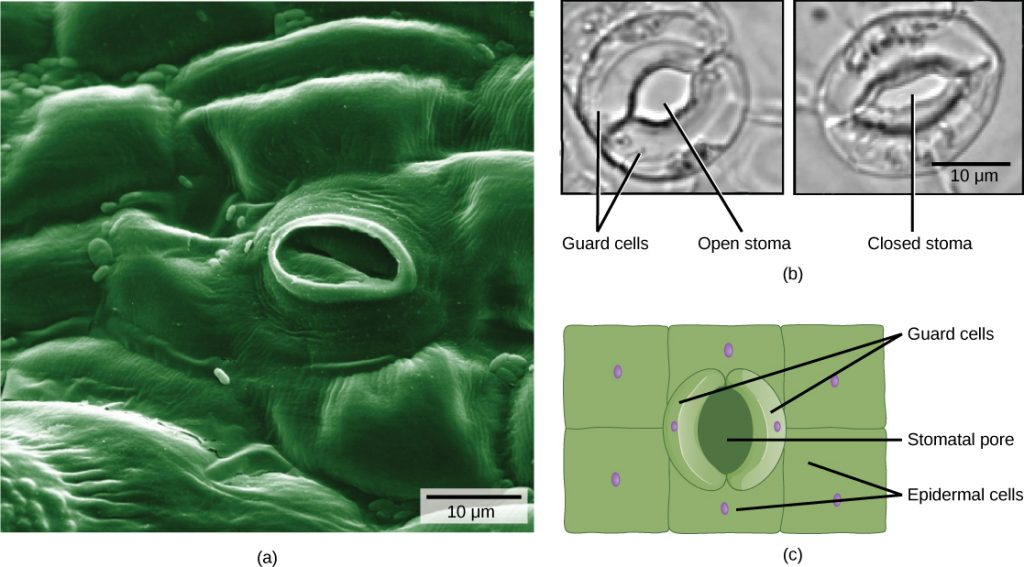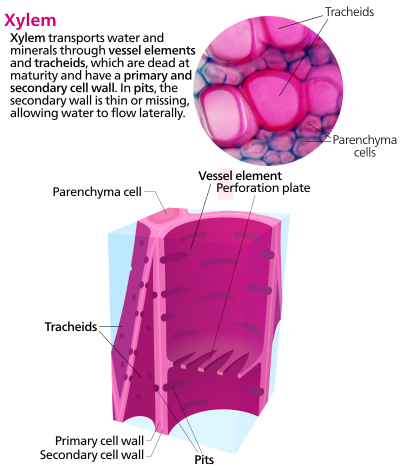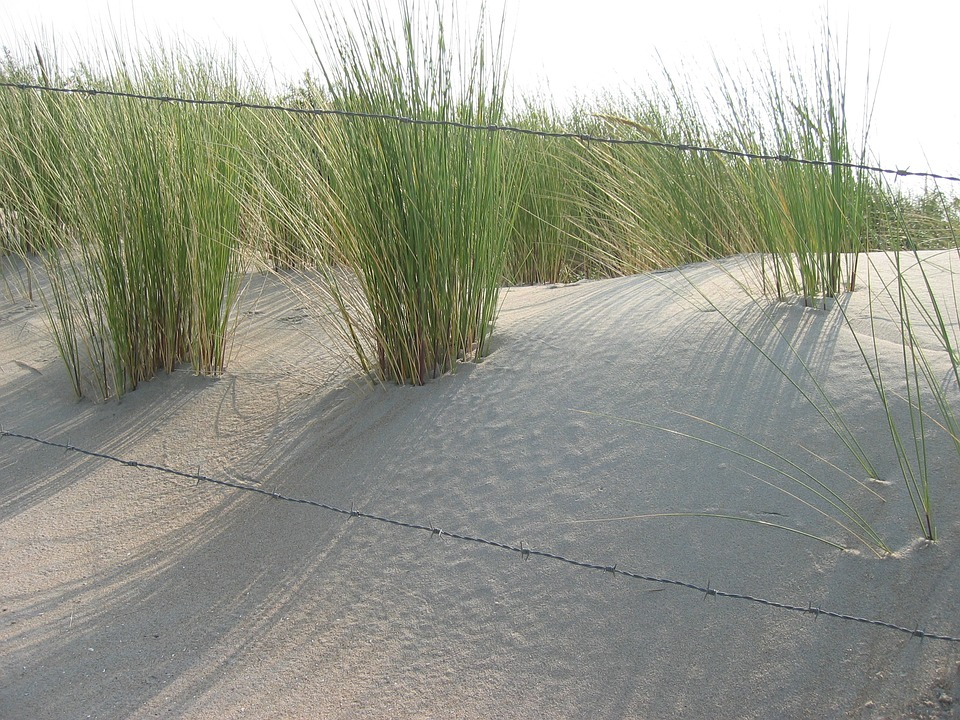Contents
Transport in Plants
The Movement of Water
Water is first absorbed by osmosis via the root hair cells, which are adapted to maximize osmosis by having thin walls and a large surface area. Once this water reaches the xylem, it is transported through the xylem hollow, thick-walled tubes to the rest of the plant. It is possible for the water to move in one direction, typically against gravity, due to water transpiring from the leaves and creating a pulling force on the water left in the plant.
Transpiration is the evaporation of water through the stomata, typically on leaves.
-
Water absorbed via root hair cells by osmosis
-
Water moving up the xylem as a continuous water column due to cohesion (cohesion-tension theory)
-
Water evaporating out of open stomata, transpiration.
As evaporation is the conversion of liquid water to water vapor, an increase in temperature will speed up this process as the water molecules gain more kinetic energy to move. If the surrounding air is less humid or there is a lot of wind to carry away evaporated water molecules, then transpiration will occur faster due to a greater concentration gradient.
Plants are able to control water loss, as stomatal opening is controlled by cells called guard cells. Guard cells swell and bend when the plant has a lot of water, resulting in the stomata opening. While water will evaporate out, carbon dioxide can also diffuse in for photosynthesis. Stomata open more when it is light and the plant cells are turgid.
Cohesion-Tension Theory
The movement of water up the xylem is linked to the properties of water.
Due to the dipolar nature of water, it forms hydrogen bonds between water molecules, creating cohesion.
This cohesion results in water forming a continuous column in the plant stem. Tension, or a pulling force, is created when the water evaporates out of the stomata. This movement of water out of the stomata results in the water column being pulled up the xylem towards the stomata. This is known as the transpiration pull. This pull will draw up the water and also put tension on the xylem, making it narrow and longer. This change in diameter of the xylem is measurable. For example, the diameter of tree trunks will change according to transpiration rates.
Xylem cells are adapted to form this continuous water column as they are hollow cells. They are hollow because they are dead cells that do not contain any organelles, and they have no end walls to enable a column to form.
Xerophytes
Xerophytes are plants with adaptations to reduce water loss and are therefore found in locations with limited water, such as the desert.
Marram grass, in the image below, is found on sand dunes. Despite being next to the ocean, there is limited water due to sand being so porous.
The micrograph below shows the adaptations more visibly. Firstly, the leaves are rolled, which helps trap any transpired water vapor to create a humid environment and prevent further transpiration. Secondly, there are tiny hair-like structures, and the stomata are sunken in pits, again to trap humid air. Trapping humid air reduces the water potential gradient, which is why transpiration is reduced. Finally, xerophytes tend to have a thicker waxy cuticle to prevent water loss and extensive root networks to reach any available water.
Measuring Transpiration
A potometer measures the rate of transpiration and can therefore be used to investigate the effect of a named environmental variable on the rate of transpiration.
A sample of a plant must be cut from a plant underwater. This is to prevent any air from entering the xylem and breaking the water column. The potometer is filled with water, and all air bubbles are removed. The cut leafy plant is then attached to the potometer, using rubber seals and petroleum jelly to make the equipment airtight. One air bubble is then introduced into the equipment, and the distance that this air bubble has moved towards the plant is recorded. To convert this into an estimate of transpiration rate, the distance the bubble moved can be used to work out the volume of water in the tube that evaporated. This volume is divided by the time it took to lose that volume of water to get a rate.
This apparatus can be reset, and different conditions can be applied to the leaf to see if the rate changes. For example, a lamp could be used to replicate sunlight, a fan may be applied to replicate wind, or a plastic bag over the plant to increase humidity.
Transport of Organic Substances
Phloem is the tube responsible for the transport of organic substances in plants, such as sugars. This transport is called translocation and is explained by the mass flow hypothesis.
Phloem tissue is made up of different cells. One cell type is the sieve tube elements, which are long and thin and arranged as a column. The name "sieve" is used to describe the fact that the end walls are perforated, like a sieve. Next to these cells are companion cells.
Translocation
Translocation is the movement of organic molecules. It is essential because photosynthesis only occurs in leaves, so the sugar that has been produced needs to be transported to all the cells in the plant to use for respiration.
Organic molecules, such as sucrose, are created in the leaves by photosynthesis. The sucrose is transported by facilitated diffusion into the companion cells, down a concentration gradient. For the sucrose to enter the sieve tube elements for mass transport around the plant, there is a co-transport protein involving hydrogen ions. Therefore, hydrogen ions must first be actively transported from the companion cells into the space between the cells to create a concentration gradient. The hydrogen ions can then transport into the sieve tube elements down a concentration gradient, attaching to the co-transport carrier protein. The sucrose molecules will also bind to the co-transport molecules and be moved into the sieve tube element cell.
Once the sucrose is transported into the sieve tube cells, they will only move en masse if there are changes in pressure. This pressure is created by varying water potentials (the pressure of water-based solutions). The movement of the sucrose into the sieve tube elements will create a more negative water potential, whereas the xylem directly next to the phloem will have a far more positive water potential. As a result, water will move from the xylem into the phloem by osmosis. This increase in volume will create a high hydrostatic pressure (pressure created by large volumes of liquid). At respiring cells, sugars are being used up, and therefore sucrose will constantly be transported into them to maintain respiration rates. This, in turn, lowers the water potential of respiring cells. Water dissolved in the phloem sugar solutions will move by osmosis into these respiring cells, decreasing the hydrostatic pressure in the phloem. Therefore, a pressure gradient is created: a higher hydrostatic pressure near the leaves and a lower hydrostatic pressure near respiring cells. This causes the solution in the phloem to move towards respiring cells.
- At what time of the day would you expect transpiration rates to be highest?
- Midday
- At what time of the day would you expect the diameter of a tree to be the smallest?
- Midday
- What property of water results in cohesion and the continuous water column?
- Your answer should include: Dipolar / Hydrogen
- What are the two cells that make up phloem tissue?
- Your answer should include: Companion / Cells / Sieve / Tube








